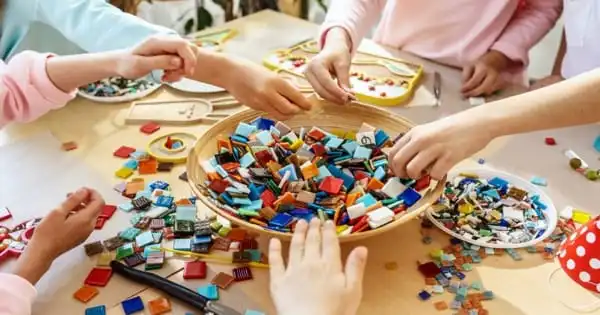According to new research, teaching youngsters in a way that encourages them to empathize with others boosts their creativity and may lead to a variety of other favorable learning outcomes.
The findings are the result of a year-long University of Cambridge research of Design and Technology year 9 students (aged 13 to 14) from two inner London schools. Pupils at one school spent the year following curriculum-required lessons, but pupils at the other school employed a set of engineering design thinking tools to enhance students’ ability to think creatively and empathically while solving real-world problems. The Torrance Tool of Creative Thinking, a well-established psychometric test, was used to assess creativity in both groups of students at the beginning and end of the school year.
The findings revealed a statistically significant increase in creativity among students attending the intervention school where the thinking tools were used. At the outset of the year, students in the control school, which followed the conventional curriculum, had 11 percent better creativity scores than those in the intervention school. By the end, however, the situation had completely changed: the intervention group’s creativity scores were 78 percent higher than the control group’s.
The researchers also looked at specific areas on the Torrance Test that are associated with emotional or cognitive empathy, such as ’emotional expressiveness’ and ‘open-mindedness.’ Pupils from the intervention school performed significantly better in these areas, demonstrating that a significant improvement in empathy was driving overall creative ratings.
We obviously awoke something in these students when we encouraged them to consider the ideas and feelings of others. The research reveals that not only is it possible to teach empathy, but that doing so promotes the development of children’s creativity as well as their overall learning.
Dr. Helen Demetriou
According to the study’s authors, increasing empathy not only enhances creativity but can also increase students’ overall involvement with learning. They discovered evidence that both boys and girls in the intervention school responded to the D&T course in ways that contradicted established gender stereotypes. Boys improved more in emotional expression, rating 64% higher at the end of the year than at the beginning of the year, while girls gained more in cognitive empathy, exhibiting 62 percent more perspective-taking.
The study is part of a long-term cooperation between the University of Cambridge’s Faculty of Education and Department of Engineering called ‘Designing Our Tomorrow’ (DOT), which is led by Bill Nicholl and Ian Hosking. It encourages students to address real-world situations by considering the views and sentiments of others.
The study’s specific challenge requested students at the intervention school to create an asthma-treatment ‘pack’ for children aged six and under. Pupils were given a variety of creative and sympathetic ‘tools’ to help them do so, such as data on the incidence of children asthma fatalities in the UK and a movie depicting a small child experiencing an attack. They also investigated the issue and tested their design concepts by playing the roles of key stakeholders, such as patients, family members, and medical professionals.
Senior Lecturer in Design and Technology Education Nicholl, who teaches teachers on the University’s D&T PGCE course, stated: “Despite being part of the D&T National Curriculum for almost two decades, teaching empathy has proved difficult. This research implies that it is a missing link in the creative process, and that it is critical if we want education to promote tomorrow’s designers and engineers.”

Dr. Helen Demetriou, an affiliated lecturer in psychology and education at the Faculty of Education with a special interest in empathy and the study’s other researcher, stated: “We obviously awoke something in these students when we encouraged them to consider the ideas and feelings of others. The research reveals that not only is it possible to teach empathy, but that doing so promotes the development of children’s creativity as well as their overall learning.”
The study’s gender disparities show that the intervention enabled pupils to overcome some of the learning barriers that presumed gender norms frequently cause. Boys, for example, are typically discouraged from expressing emotion at school, despite the fact that this was one of the key areas where they made considerable creative advances, according to the exams.
In addition to the Torrance Tests, the researchers interviewed students from both the intervention school and a third (girls-only) school that also participated in the asthma challenge. This response revealed that students empathized deeply with the issues experienced by young asthma sufferers, which influenced their innovative judgments in the classroom.
When discussing patients and their families, several used terms like’stepping into their shoes’ or’seeing things from another perspective.’ “I think by the conclusion of the project, I could feel for the people with asthma… if I was a child taking inhalers, I would be terrified too,” one boy told the researchers.
Another person responded: “Assume you have a sister or brother who is in that position. I’d like to do something similar so that we can assist them.” Overall, the authors argue that these findings speak to the need to cultivate ’emotionally intelligent learners’ not only in D&T classes, but across topics, especially in light of new, broader scientific evidence that our ability for empathy fades with age.
“This is something we must consider as curricula in general grow more exam-based,” Demetriou added. “Good grades are important, but for society to prosper, creative, communicative, and compassionate persons are also important.”
Nicholl continued: “When I taught Design and Technology, I didn’t regard them as future engineers who would contribute to the economy; I saw them as people who needed to be ready to enter the world at the age of 18. Teaching children to empathize is a step toward creating a society in which we value each other’s opinions. Surely, it is what we want education to do.”





